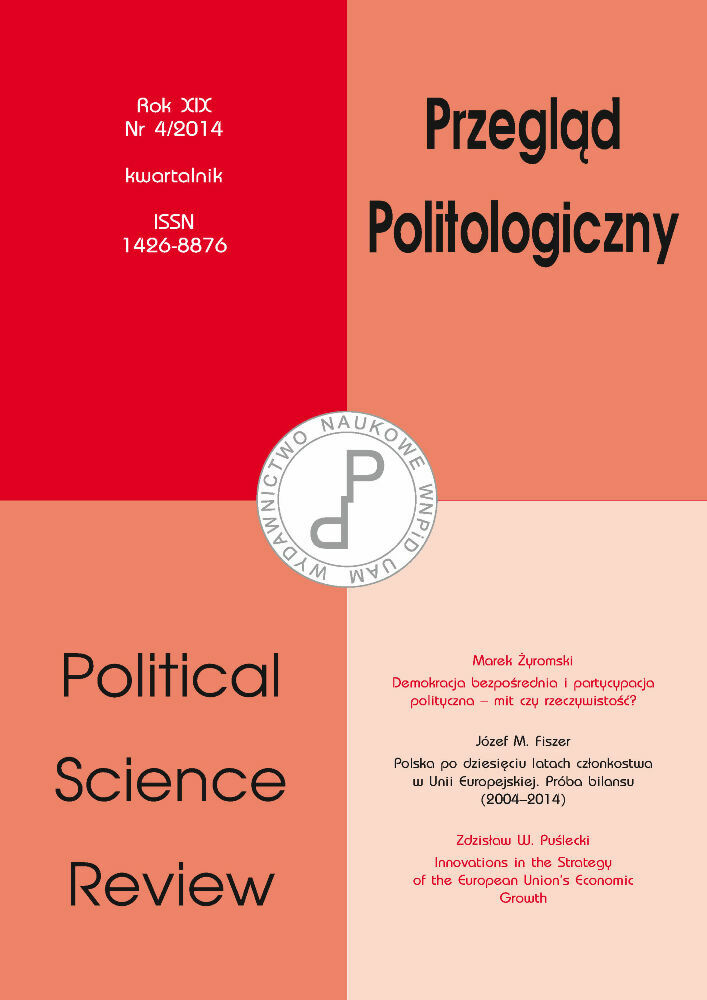Abstract
The main aim of the paper is the presentation of the innovation system in the strategy of the European Union’s economic growth. According to the new theory of growth being the best theoretical foundation for the concept of the innovation system, the primary factor influencing the economic growth is the endogenous technological progress. To the particular goals of the research belong the presentation of the model of innovation system, theoretical concept of the innovation system and innovation process, constructed advantage, the Triple Helix model, Innovation Union, Europe 2020 strategy, Horizon 2020 as the financial instrument implementing the Innovation Union. The problems were researched by quantity and quality scientific methods. Utilised also, deduction and induction, statistic and prognostic methods. The important results of the research is the conclusion that in the innovation process also in the European Union very important are the connection between science, market (industry) and governance. There is positive dependence between innovation activity and effectiveness of the innovation process. The more interaction and cooperation it can observe on the regional level than on the state. The new programme of the Europe 2020 and Innovation Union are very important factors of the strategy the EU economic growth.
References
Best M. (2001), The New Competitive Advantage, Oxford University Press, Oxford.
Cooke P. (1992), Regional innovation systems: competitive regulation in the new Europe, “Geoforum”, no. 23, p. 365–382.
Cooke P., Heidenreich M., Braczyk H. (2004), Regional Innovation Systems (Second Edition), Routledge, London.
Cooke P., Leydesdorff L. (2006), Regional Development in the Knowledge-Based Economy: The Construction of Advantage, “Journal of Technology Transfer”, January, vol. 31, Issue 1, p. 5–15.
De la Mothe J., Mallory G. (2003), Industry-Government Relations in a Knowledge-Based Economy: the Role of Constructed Advantage, PRIME Discussion Paper 02-03, University of Ottawa: Program of Research in Innovation Management & Economy.
Dunning J. (ed.), (2000), Regions, Globalisation & the Knowledge-Based Economy, Oxford University Press, Oxford.
“Economic Bulletin”, (2002).
Etzkowitz H., Leydesdorff L. (1998), The Endless Transition: A “Triple Helix” of University-Industry-Government Relations, “Minerva”, no. 36, p. 203–208.
Foray D., Freeman C. (1993), Technology and the Wealth of Nations: The Dynamics of Constructed Advantage, Pinter, London.
Freeman C. (1987), Technology Policy and Economic Performance: Lessons from Japan, Pinter, London.
Freeman C. (1988), Japan, a New System of Innovation, in: Technical Change and Economic Theory, eds. G. Dosi, C. Freeman, R. R. Nelson, G. Silverberg, L. Soete, Pinter, London, p. 31–54.
Growth, competitiveness and jobs priorities for the European Semester 2013 (2014), Presentation of J. M. Barroso, President of the European Commission to the European Council of 14–15 March 2013 (2014), http://europa.eu/news/pdf/sg.2013-00286-01-04-eu.tra-00.pdf, 24.01.2014.
Huges B. B., Irfan M. T. (2008), Assessing Strategies for Reducing Global Poverty, in: North and South in the World Political Economy, eds. R. Reuveny, W. R. Thompson, Blackwell Publishing Ltd., Malden USA, Oxford UK, Carlton Victoria Australia.
Krugman P. (1995), Development, Geography & Economic Theory, MIT Press, Cambridge.
Leydesdorff L. (1994), Epilogue, in: Evolutionary Economics and Chaos Theory: New Directions for Technology Studies, eds. L. Leydesdorff, P. Van den Besselaar, Pinter, London–New York, p. 180–192.
Lundvall B.-Å. (1988), Innovation as an Interactive Process: From User-Producer Interaction to the National System of Innovation, in: Technical Change and Economic Theory, eds. G. Dosi, C. Freeman, R. Nelson, G. Silverberg, L. Soete, Pinter, London, p. 349–369.
Lundvall B.-Å. (ed.), (1992), National Systems of Innovation, Pinter, London.
Marshall A. (1916), Principles of Economics, Macmillan, London.
Nelson R. R. (ed.), (1982), Government and Technical Progress: A Cross-Industry Analysis, Pergamon, New York.
Nelson R. R. (ed.), (1993), National Innovation Systems: A comparative study, Oxford University Press, Oxford–New York.
Ohlin B. (1993), Interregional and International Trade, Harvard Business Press, Cambridge.
Pavitt K. (1984), Sectoral patterns of technical change: towards a theory and a taxonomy, “Research Policy”, no. 13, p. 343–373.
Porter M. (1990), The Competitive Advantage of Nations, The Free Press, New York.
Porter M. (1998), On Competition, Harvard Business School Press, Boston.
Schumpeter J. (1911), The Theory of Economic Development, Oxford University Press, Oxford, p. 57.
SEC (2011), 1428 final Volume 1, Commission Staff Working Paper Executive Summary of the Impact Assessment Accompanying the Communication from the Commission “Horizon 2020 – The Framework Programme for Research and Innovation”, Brussels, 30.11.2011.
Wójnicka E. (2008), Interactions in the innovation process as a factor of competitiveness of companies: http://www.4pm.pl/artykul/interakcje_w_procesie_innowacyjnym_jako_czynnik_konkurencyjosci_przedsiebiorstw_czesc_1-37-54.html, 2009, 1.
